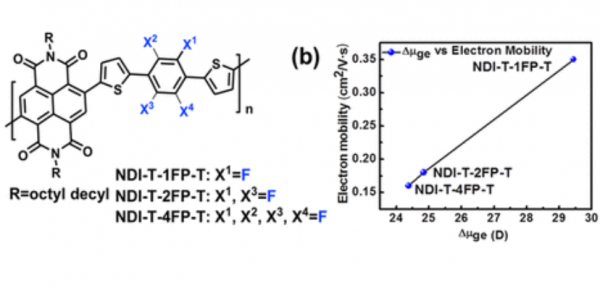Sequential Fluorination on Napthaleneamide-Based Conjugated Polymers and Their Impact on Charge Transport Properties
- 저자
- Kakaraparthi Kranthiraja, Dang Xuan Long, Vijaya Gopalan Sree, Woosum Cho, Young-Rae Cho,Abbas Zaheer, Jong-Cheol Lee, Yong-Young Noh*, and Sung-Ho Jin*
- 저널명
- Macromolecules, 51, 15, 5530–5536 (2018)
- 년도
- 2018
- Link
- https://doi.org/10.1021/acs.macromol.8b00748 544회 연결
[Abstract]
Improving π-conjugated polymer electron transport and injection efficiency are important to realize high performance n-channel organic field-effect transistors (OFETs). This paper reports a series of naphthalene diimide (NDI-) based n-type π-conjugated polymers, NDI-T-1FP-T, NDI-T-2FP-T, and NDI-T-4FP-T, with varioulis amounts of fluorine atoms (1F, 2F, and 4F) in their backbones. We found notable differences in energy levels, ground and excited state dipole moments (Δμge), exciton lifetimes, dihedral angles, and charge transport properties by varying the fluorine content: Δμge and charge transport properties reduced with increasing fluorine content. Electron mobility of optimized top gate bottom contact OFETs using the n-type π-conjugated polymers were 0.35, 0.18, and 0.16 cm2 V–1 s–1, respectively. OFET performances were further improved further by low concentration polyethylenimine (PEI) doping, significantly improving field-effect mobility to (maximum) 0.51, 0.34, and 0.26 cm2 V–1 s–1, respectively. Doped NDI-T-4FP-T with 4F in particular showed unipolar n-channel behavior by depletion of the hole current.
